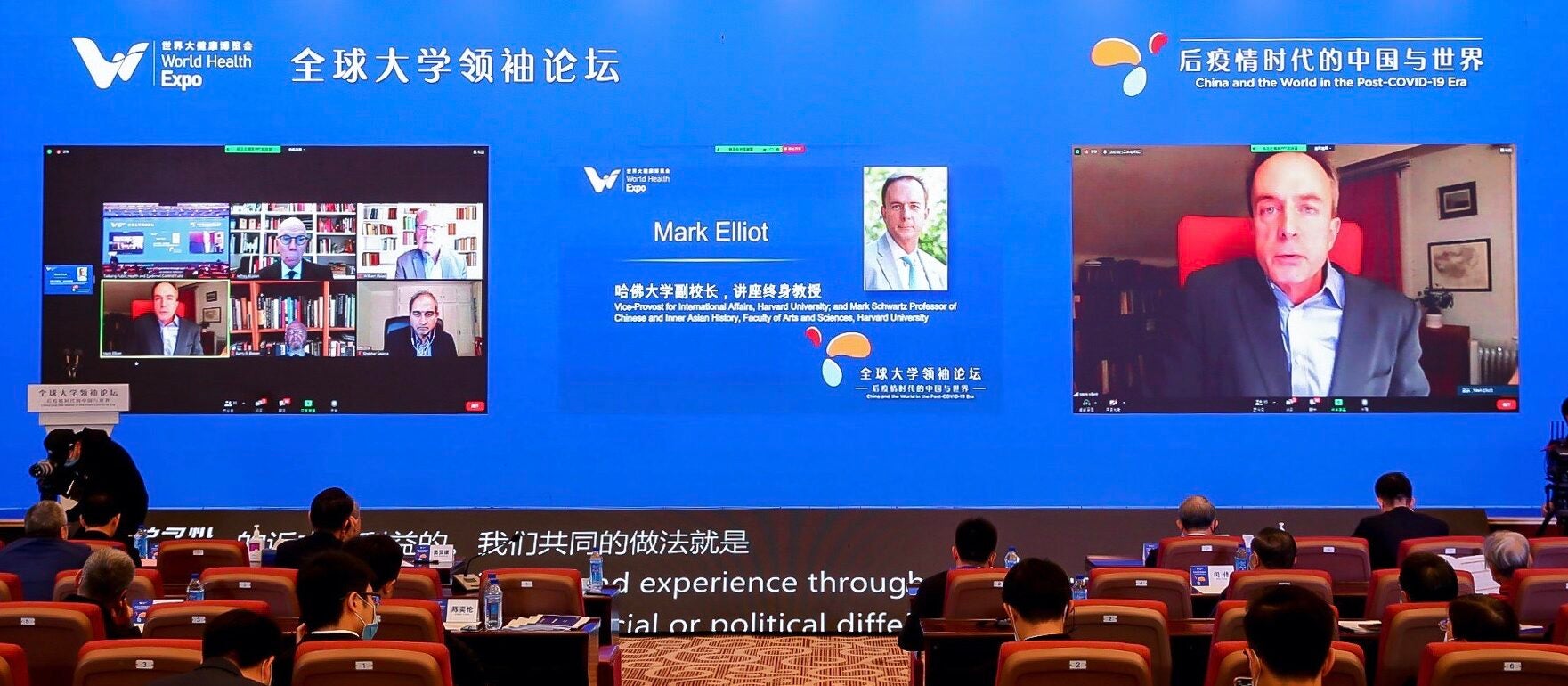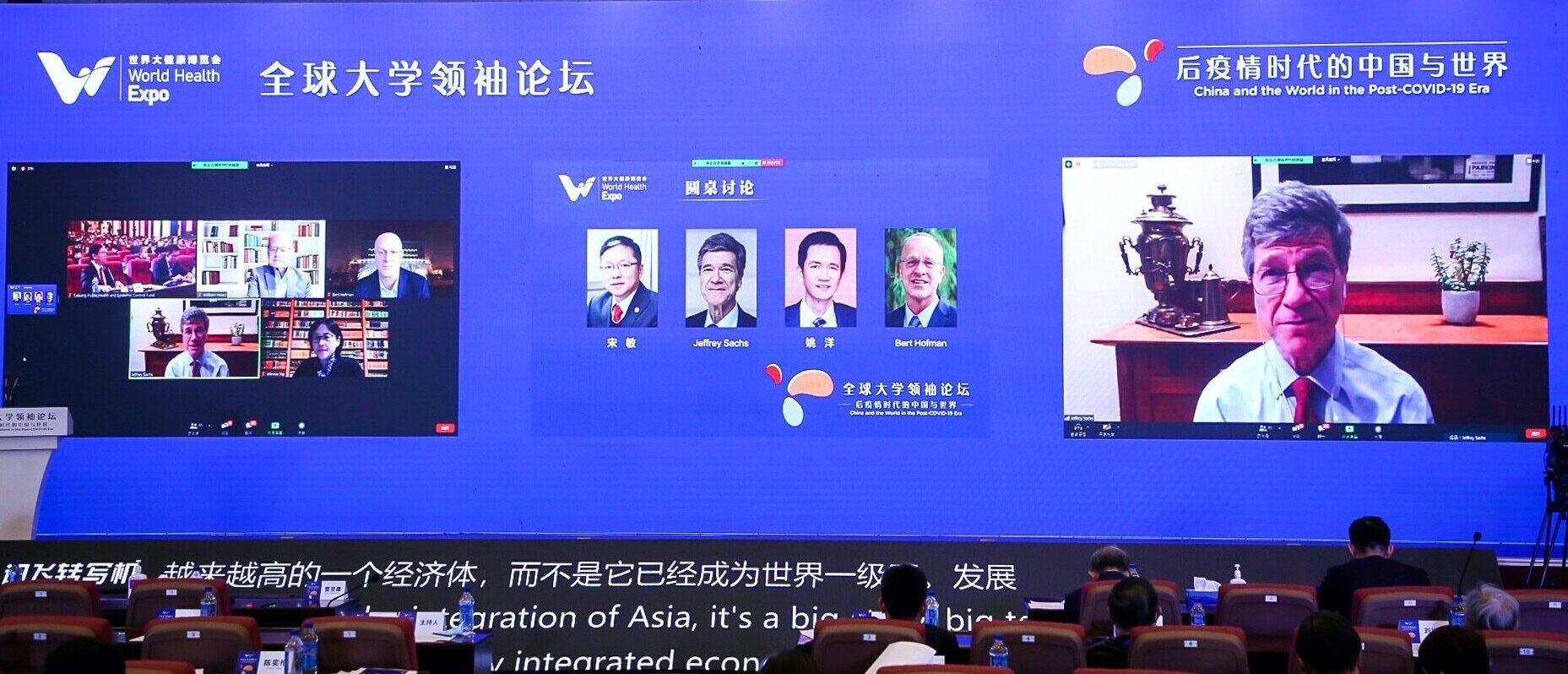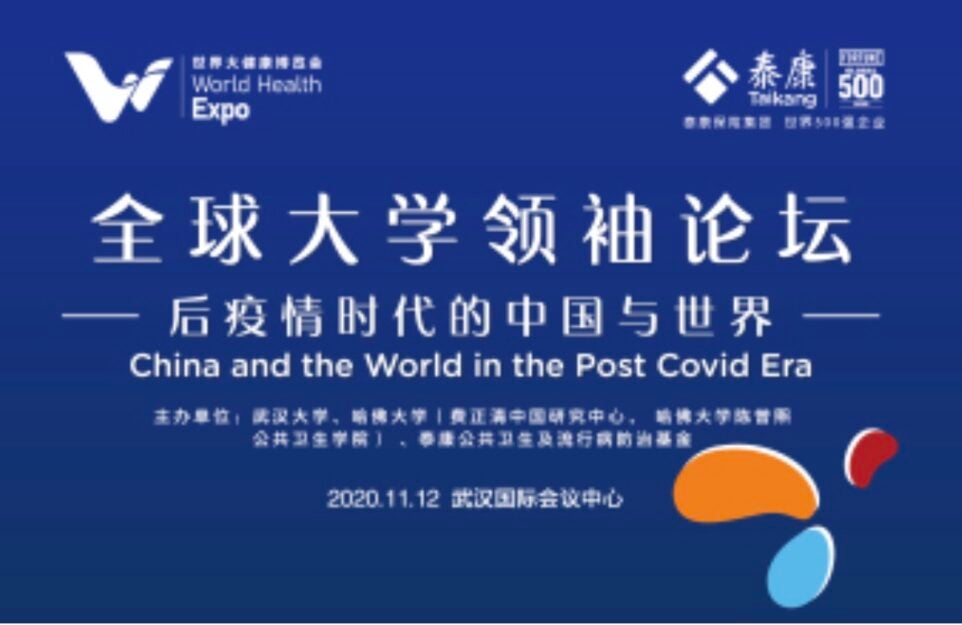The Harvard China Health Partnership and the Fairbank Center for Chinese Studies co-organized a forum with Wuhan University on November 11, 2020 entitled “China and the World in the Post-COVID-19 Era.” Organized in two sessions underscoring the pandemic’s lingering effects on public health and the global economy, the event drew 300 people attending in-person, over 100 members of the international community attending on-line, and over 170,000 attending on-line from China. Event speakers–including keynote speakers Jeffrey D. Sachs (Columbia University) and Jeffrey Koplan (Emory University)–enumerated multiple areas where cooperation between the United States and China can yield benefits for both countries, even as the overall relationship becomes characterized by competition.
Agenda and Speakers
Session I: Broader Implications on Global Health and Psycho-Social Impacts
- Winnie Yip (叶志敏), Professor of Global Health Policy and Economics, Harvard T.H. Chan School of Public Health; Interim Director, Fairbank Center for Chinese Studies, Harvard University
- Jeffrey Koplan, Vice-President for Global Health, Emory University; Former Director, U.S. Centers for Disease Control
- Barry Bloom, Joan and Julius Jacobson Research Professor of Public Health, Professor of Immunology and Infectious Diseases, and Former Dean, Harvard T.H. Chan School of Public Health
- Ruiping Xiao (肖瑞平), Director, Institute of Molecular Medicine, Peking University; Associate Editor , New England Journal of Medicine
- Shekhar Saxena, Professor of Global Mental Health, Harvard T.H. Chan School of Public Health
Session II: The Future Under Global Economic Integration
- Min Song (宋敏), Dean of School of Economics and Management, Wuhan University
- Jeffrey D. Sachs, University Professor and Director, Center for Sustainable Development, Columbia University
- Yang Yao (姚洋), Dean, National School of Development at Peking University
- Bert Hofman (郝福满), Director of the East Asian Institute at National University of Singapore, Professor of Practice at the Lee Kuan Yew School
Opening and Closing
- Qizhu Tang (唐其柱), Vice President, Wuhan University; Dean, Wuhan University School of Medicine
- Juhua Xiao (肖菊华), Vice-Governor of Hubei Province
- Honghui Chen (陈红辉), Vice-Mayor of Wuhan
- Xiankang Dou (窦贤康), President, Wuhan University
- Mark Elliott (欧立德), Vice-Provost for International Affairs, Harvard University; and Mark Schwartz Professor of Chinese and Inner Asian History, Faculty of Arts and Sciences, Harvard University
- Wannian Liang (梁万年), Executive Associate Dean of Tsinghua University, Vanke School of Public Health; former Director-General of Healthcare Reform, National Health Commission of China
- William Hsiao (萧庆伦), Emeritus Professor of Economics, Department of Health Policy and Management, Harvard T.H. Chan School of Public Health
- Dongsheng Chen (陈东升), Chairman of Dong Fureng Research Institute of Wuhan University; Founder, Chairman and CEO of Taikang Insurance Group
Organized by Wuhan University (School of Medicine, and School of Economics and Management), Fairbank Center for Chinese Studies, Harvard University, and Harvard T.H. Chan School of Public Health; and sponsored by the Taikang Public Health and Epidemic Control Fund.


Summary
The Harvard China Health Partnership and the Fairbank Center for Chinese Studies co-organized a forum with Wuhan University on November 11, 2020 entitled “China and the World in the Post-COVID-19 Era.” Organized in two sessions underscoring the pandemic’s lingering effects on public health and the global economy, the event drew 300 people attending in-person, over 100 members of the international community attending on-line, and over 170,000 attending on-line from China. Event speakers enumerated multiple areas where cooperation between the United States and China can yield benefits for both countries, even as the overall relationship becomes characterized by competition.
Harvard University Vice Provost for International Affairs Mark Elliott opened the forum by highlighting Harvard’s history of engagement with China over more than a century, including collaborations in the fields of public health and medicine. In an interconnected and interdependent world, he argued that political differences should not unwind important academic collaborations that benefit all countries across the globe.
Beginning the forum’s session on public health, moderator Winnie (Chi-Man) Yip, Professor of Global Health and Economics at the Harvard T.H. Chan School of Public Health, observed that under the current tense U.S.-China relations, health is an area in which collaboration will produce mutual benefits. Former Director, U.S. Centers for Disease Control and Prevention, Jeffrey Koplan recognized China’s success in containing the COVID-19 outbreak but encouraged a collegial approach to controlling the virus because all countries remain at risk. Beyond the pandemic, he highlighted many other health-related challenges the United States and China can tackle together, including improving access, cost, and quality of health care, improving health services for aging populations, reducing risks from non-communicable diseases, and many more. He also advocated for the restoration of collaborations between the two countries’ CDCs.
Addressing a practical issue in the fight against COVID-19, Barry Bloom, Joan L. and Julius H. Jacobson Research Professor of Public Health at the Harvard T.H. Chan School of Public Health, discussed the current state of COVID-19 vaccine research. The virus’s DNA sequence published early on by Chinese researchers served as the foundation for vaccine research. Currently, around 45 vaccine candidates are undergoing clinical trials around the world, with all leading vaccines targeting the virus’s spike protein. However, vaccine development takes time and there are no guarantees. Even if an effective vaccine is created, the general populace must be willing to take a vaccine for it to be effective, so the research process must inspire trust. Any vaccine would initially be in short supply, and the world must grapple with questions about how it should be distributed. The U.S. National Academies of Science, Engineering, and Medicine has proposed a framework prioritizing people in high-risk categories, and at an international level, 188 countries—including China—have signed on to COVAX to help promote equitable access to a COVID-19 vaccine.
The toll taken by the pandemic has been not only physical but psychological as well. Shekhar Saxena, Professor of Global Mental Health at the Harvard T.H. Chan School of Public Health, expressed concern over how the pandemic has impacted mental health. Increases in mental health challenges have been brought about by factors including job and financial insecurity, working from home, school and college closures, lack of access to food, and increases in domestic violence, among others. The impact on mental health has varied between different population groups and countries. Vulnerable populations such as migrant workers, people struggling with substance abuse, front-line health workers, and those with existing mental health conditions are particularly susceptible to the pandemic’s abundant effects on mental health.
In the face of the challenges brought to the international community by COVID-19, Ruiping Xiao, Director of Peking University’s Institute of Molecular Medicine, acknowledged some of the positive ways that the scientific community has adapted to cope with the virus. COVID-19 has spurred innovative applications of Artificial Intelligence and technology to track virus transmission, information dissemination happens more quickly, and decisions on research funding are reached more swiftly.
Though the pandemic started as a public health crisis, but the resulting economic fallout is now undeniable. A second panel of experts moderated by Song Min, Dean of Wuhan University’s School of Economics and Management, analyzed the virus’s economic impact as well as consequences for international relations. University Professor at Columbia University Jeffrey Sachs addressed ways in which political dynamics in the United States have hampered economic engagement with China. Among the factors influencing this reality is the reduction in manufacturing jobs in the United States. He argued that though these reductions were primarily a result of increases in automation and efficiency, politicians have blamed China. When China implemented the China 2025 program, it further stoked fears that China is not only growing economically but is also surging ahead technologically. Professor Sachs urged both countries to overcome barriers to cooperation not only to bring an early end to the pandemic, but also to take urgently needed action in areas of mutual interest like climate change.
China’s economy has shown signs of recovery since bringing the virus under control domestically, giving reason for cautious optimism. According to Yang Yao, Dean of Peking University’s National School of Development, China is on track for 1.8 – 2.0% annual growth for 2020. However, this growth has not been balanced; investment and exports have accounted for a significant proportion of growth over the past six months. China must move to a more sustainable growth model because countries paralyzed by the pandemic will eventually be able to resume domestic production, and China’s export growth will slow. Dean Yao anticipates that economic and technological competition between the United States and China will continue, but suggests that the level of competition can be limited to a manageable level.
Bert Hofman, Director of the East Asian Institute at the National University of Singapore, discussed changes in trade flow patterns. Though the pandemic caused an initial decline in trade, this decline was short-lived. The services sector took a substantial hit, but the level of automation in manufacturing has allowed the manufacturing sector to recover relatively well. Of bigger consequence to trade patterns has been China’s movement up the global value chain as well as changes in trade instigated by the trade war. China commands the largest share of any country in global manufacturing, and its evolution into a producer and exporter of intermediate goods makes it even more integral to global value chains. However, exports to the United States in 2019—the last pre-pandemic reference point—exhibited a 15% decline, a change primarily attributable to the trade war. Exports to the United States have increased during the pandemic, but when these temporary effects eventually recede, exports bound for the United States are expected to again fall. In response, China will try to reorient exports towards ASEAN countries.
In closing the forum, William Hsiao, K.T. Li Professor of Economics, Emeritus at the Harvard T.H. Chan School of Public Health, emphasized that the world remains highly interconnected. China’s economy relies on the world economy, and the world economy relies on China’s economy. Cooperation between the United States and China can still increase the size of the economic pie so that all countries benefit, and with an eye to the future, Professor Hsiao shared his hope that both countries will leverage these opportunities.
Resources:
- Please see additional information in the program agenda here.
- Sina, a general interest media outlet in China, summarized the event here.
- China Healthcare, a healthcare industry media outlet in China, summarized the event here, with additional pictures.


